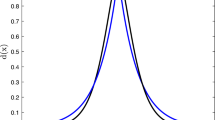Abstract
We develop a reliable a posteriori anisotropic first order estimator for the numerical simulation of the Frankfort and Marigo model of brittle fracture, after its approximation by means of the Ambrosio-Tortorelli variational model. We show that an adaptive algorithm based on this estimator reproduces all the previously obtained well-known benchmarks on fracture development with particular attention to the fracture directionality. Additionally, we explain why our method, based on an extremely careful tuning of the anisotropic adaptation, has the potential of outperforming significantly in terms of numerical complexity the ones used to achieve similar degrees of accuracy in previous studies.
Access this chapter
Tax calculation will be finalised at checkout
Purchases are for personal use only
Similar content being viewed by others
References
Ambrosio, L., Tortorelli, V.M.: Approximation of functionals depending on jumps by elliptic functionals via γ-convergence. Commun. Pure Appl. Math. 43(8), 999–1036 (1990)
Amestoy, M.: Propagations de Fissures en Élasticité Plane. Thèse d’Etat, Paris (1987)
Artina, M., Fornasier, M., Solombrino, F.: Linearly constrained nonsmooth and nonconvex minimization. SIAM J. Optim. 23(3), 1904–1937 (2013)
Artina, M., Fornasier, M., Micheletti, S., Perotto, S.: Anisotropic adaptive meshes for brittle fractures: parameter sensitivity. Numerical Mathematics and Advanced Applications ENUMATH 2013. Springer International Publishing 293–301 (2015)
Artina, M., Fornasier, M., Micheletti, S., Perotto, S.: Anisotropic mesh adaptation for crack detection in brittle materials. MOX Report 20/2014 (2014)
Border, M., Verhoosel, C., Scott, M., Hughes, T., Landis, C.: A phase-field description of dynamic brittle fracture. Comput. Methods Appl. Mech. Eng. 217–220, 77–95 (2012)
Bourdin, B., Francfort, G., Marigo, J.J.: Numerical experiments in revisited brittle fracture. J. Mech. Phys. Solids 48(4), 797–826 (2000)
Burke, S., Ortner, C., Süli, E.: An adaptive finite element approximation of a variational model of brittle fracture. SIAM J. Numer. Anal. 48(3), 980–1012 (2010)
Burke, S., Ortner, C., Süli, E.: An adaptive finite element approximation of a generalized Ambrosio-Tortorelli functional. Math. Models Methods Appl. Sci. 23(9), 1663–1697 (2013)
Chambolle, A., Dal Maso, G.: Discrete approximation of the Mumford-Shah functional in dimension two. M2AN Math. Model. Numer. Anal. 33(4), 651–672 (1999)
Ciarlet, P.G.: The Finite Element Method for Elliptic Problems. North-Holland, Amsterdam (1978)
Ciarlet, P.G., Raviart, P.A.: Maximum principle and uniform convergence for the finite element method. Comput. Methods Appl. Mech. Eng. 2(1), 17–31 (1973)
Clément, P.: Approximation by finite element functions using local regularization. RAIRO Anal. Numér. 2, 77–84 (1975)
Dal Maso, G.: An Introduction to Γ-Convergence. Birkhäuser, Basel (1993)
Dedè, L., Micheletti, S., Perotto, S.: Anisotropic error control for environmental applications. Appl. Numer. Math. 58(9), 1320–1339 (2008)
Del Piero, G., Lancioni, G., March, R.: A variational model for fracture mechanics: numerical experiments. J. Mech. Phys. Solids 55, 2513–2537 (2007)
Formaggia, L., Perotto, S.: New anisotropic a priori error estimates. Numer. Math. 89(4), 641–667 (2001)
Formaggia, L., Perotto, S.: Anisotropic error estimates for elliptic problems. Numer. Math. 94, 67–92 (2003)
Francfort, G., Marigo, J.J.: Revisiting brittle fracture as an energy minimization problem. J. Mech. Phys. Solids 46(8), 1319–1342 (1998)
George, P.L., Borouchaki, H.: Delaunay Triangulation and Meshing. Application to Finite Elements. Edition Hermès, Paris (1998)
Hecht, F.: New developments in Freefem++. J. Numer. Math. 20(3–4), 251–265 (2012)
Korotov, S., Křížek, M., Neittaanmäki, P.: Weakened acute type condition for tetrahedral triangulations and the discrete maximum principle. Math. Comput. 70(233), 107–119 (2001)
Lions, J.L., Magenes, E.: Non-homogeneous Boundary Value Problems and Applications, vol. I. Springer, Berlin (1972)
Micheletti, S., Perotto, S.: Reliability and efficiency of an anisotropic Zienkiewicz–Zhu error estimator. Comput. Methods Appl. Mech. Eng. 195(9), 799–835 (2006)
Micheletti, S., Perotto, S.: Output functional control for nonlinear equations driven by anisotropic mesh adaption: the Navier-Stokes equations. SIAM J. Sci. Comput. 30(6), 2817–2854 (2008)
Micheletti, S., Perotto, S.: The effect of anisotropic mesh adaptation on PDE-constrained optimal control problems. SIAM J. Control. Optim. 49(4), 1793–1828 (2011)
Micheletti, S., Perotto, S., Picasso, M.: Stabilized finite elements on anisotropic meshes: a priori error estimates for the advection–diffusion and the Stokes problems. SIAM J. Numer. Anal. 41(3), 1131–1162 (2003)
Miehe, C., Hofacker, M., Fabian, W.: A phase field model rate-independent crack propagation: robust algorithmic implementation based on operator splits. Comput. Methods Appl. Mech. Eng. 199(45–48), 2765–2778 (2010)
Strang, G., Fix, G.J.: An Analysis of the Finite Element Method, vol. 212. Prentice-Hall, Englewood Cliffs (1973)
Thomée, V.: Galerkin Finite Element Methods for Parabolic Problems, vol. 25. Springer, Berlin (1997)
Author information
Authors and Affiliations
Corresponding author
Editor information
Editors and Affiliations
Rights and permissions
Copyright information
© 2015 Springer International Publishing Switzerland
About this chapter
Cite this chapter
Artina, M., Fornasier, M., Micheletti, S., Perotto, S. (2015). The Benefits of Anisotropic Mesh Adaptation for Brittle Fractures Under Plane-Strain Conditions. In: Perotto, S., Formaggia, L. (eds) New Challenges in Grid Generation and Adaptivity for Scientific Computing. SEMA SIMAI Springer Series, vol 5. Springer, Cham. https://doi.org/10.1007/978-3-319-06053-8_3
Download citation
DOI: https://doi.org/10.1007/978-3-319-06053-8_3
Publisher Name: Springer, Cham
Print ISBN: 978-3-319-06052-1
Online ISBN: 978-3-319-06053-8
eBook Packages: Mathematics and StatisticsMathematics and Statistics (R0)




